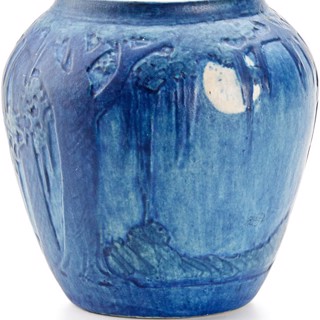
Henrietta Bailey was born in New Orleans in 1874. She completed the undergraduate and graduate programs in art at Newcomb College, famous for the Newcomb Pottery. In 1905, thanks to a scholarship, she spent the summer in Ipswich, Massachusetts, developing her arts and crafts style with influential painter and printmaker Arthur Wesley Dow. She returned to Newcomb as an independent designer and then an official Art Craftsman. She decorated pottery, made prints, and substituted for china painting classes. In 1926, she joined the art faculty, and she taught at Newcomb until she retired in 1938 — she dedicated over 30 years of her life to her school. During this time, she created scores of atmospheric ceramics and blockprints of foggy Louisiana swamps and bayous.
Bailey exhibited in the 1915 Panama Pacific Exposition in San Francisco, California, and in 1931 she placed first in the Southern States Art Leagues Exhibition, Savannah, Georgia for the best collection of decorated pottery. The Art League also awarded her for a block print in 1932. Her ceramics were shown at the Houston’s Museum of Fine Arts, the Arts Association of New Orleans, and other prominent southern galleries.
Newcomb College, the women’s branch of Tulane University, educated women in arts and crafts vocations. When brothers William and Ellsworth Woodward arrived in the 1880s, they fell in with this philosophy and founded the Newcomb Pottery to embody the Arts and Crafts movement. Arts and Crafts reacted against sterile, overly ornate, machine-produced objects of design which paid no respect to their materials or to the individual people responsible for them. The associated artists sought to ground their largely handmade works in the imagery and the native resources of the place that birthed them. So the Newcomb Pottery hired local artisans to hand-turn unique, decorative yet functional bowls, plates, and vases from Louisiana clay, decorated mainly with southern flora and fauna as well as the signature transparent mat glaze they developed. A complex language of marks gave credit to each artist involved in the production of the piece.
Newcomb pottery took prizes in eight international exhibitions. As more and more buyers clamored for their own piece, the potters toned down their creativity in order to churn out enough, and the high prices consigned the pieces, ironically, to luxury items. Through the 20s and 30s, as art fads shifted, the pillars of the pottery retired, and it finally faded out in 1940, leaving behind some of the finest American pottery of its period.
Sources include:
AskArt, https://www.askart.com/artist/Henrietta_Davidson_Bailey/123530/Henrietta_Davidson_Bailey.aspx
Newcomb Art Museum, https://newcombartmuseum.tulane.edu/portfolio-item/artisans/
